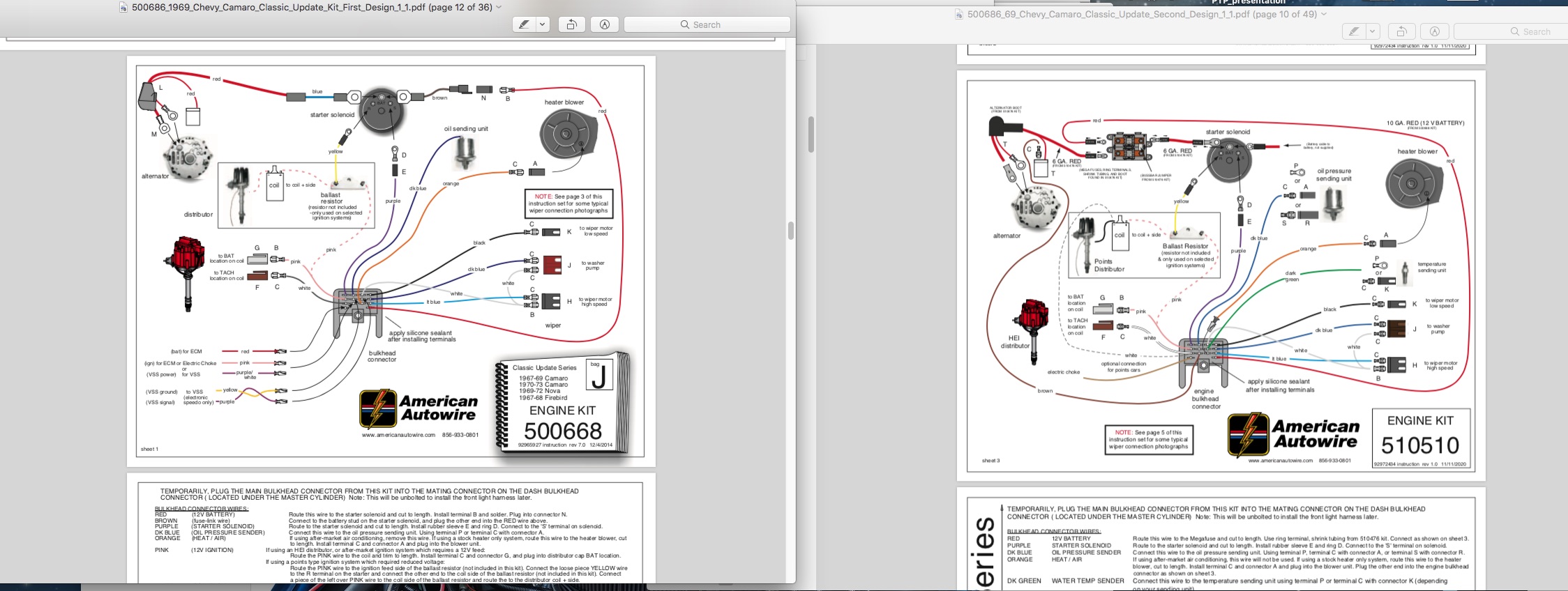Results 1 to 10 of 10
-
09-22-2022 #1
Positive battery cable routing on 68 Camaro
Here is my question. My 140 amp painless alternator kit tells me to run the 6 gauge charge cable to the included breaker and then to the positive battery post. I also have the 6 gauge standard battery cable going to the starter. No I have two 6 gauge cables to mount on my positive battery posts (optima battery with two posts).
Is this the best setup? Two positive battery cables to the battery?
I know I can run the alternator cable also to the starter but is it preferred to have it go directly to the battery through the 150 amp breaker?
-
09-22-2022 #2
09-23-2022 #3 Registered User
Registered User
- Join Date
- Jan 2018
- Location
- Saint Louis, Missouri
- Posts
- 87
Personally I do not like how they have a 6 gauge wire and an unknown gauge wire protected by the 200A fuse.
A 6 gauge wire may be fine with a 200A fuse but in the drawing there is a smaller wire and no gauge called out and if it is let's say an 8 or 10 gauge wire, protecting it with a 200A fuse is way to much in my opinion.
Jim
09-23-2022 #4 Registered User
Registered User
- Join Date
- Aug 2007
- Posts
- 259
09-23-2022 #5 Registered User
Registered User
- Join Date
- Aug 2007
- Posts
- 259
09-23-2022 #6 Registered User
Registered User
- Join Date
- Aug 2007
- Posts
- 645
I would call Painless and ask for help. I've used Painless a number of times and have found their tech folks quite good.
09-24-2022 #7 Registered User
Registered User
- Join Date
- Jan 2018
- Location
- Saint Louis, Missouri
- Posts
- 87
I too would ask the company what they recommend as they will know the type of wire and length.
If you were to have let's say a 175A fuse on a 10 gauge wire, I have to think in a direct short situation, that fuse would blow as well as let's say an 80A fuse.
My issue would be a 10 gauge is sized for so much power and during a dead short situation the wire may be asked to pass 1000A out of a battery and then the 175A fuse would blow BUT I wonder what would happen, and how much voltage drop one might have is if the 10 gauge wire is sized for a 60A load, what happens if we try and pass let's say 150A and now the 175A would not be blowing but would the 10 gauge wires insulation start to become damaged or the related terminals on that run, and/or will the end of the wire have more than an acceptable voltage drop on the far end.
I like the second design with two fuses as this would allow for different gauge wires (10 gauge and a 6 gauge).
Another concern of mine is let's say the total amp draw on the 10 gauge is 100A and this current passes through a single male/female terminal on the bulkhead and then from what I have read, and they may be using something different, is the bulkhead connector may only be designed for 50A and then this can create voltage drops and overheating. This is what I'm wondering looking at some original setups that the main feed terminals on the bulkheads have discoloration from excessive current flow (ad not to be confused with the black colored sealant that was used back in the day).
Yep, call the company and see what they say.
Jim
09-24-2022 #8Keep in mind that fuses need to be derated for reliability and temperature effects. Typically 50% derating. A 200 amp fuse will fuse at a significantly lower current in the hot under hood environment. Datasheet for specific fuses will show the effect of temperature.
Data for the Mega Fuse below.
Don1969 Camaro - LSA 6L90E AME sub/IRS
1957 Buick Estate Wagon
1959 El Camino - Ironworks frame
1956 Cameo - full C5 suspension/drivetrain
1959 Apache Fleetside
09-26-2022 #9
09-28-2022 #10 Registered User
Registered User
- Join Date
- Aug 2007
- Posts
- 259




 Reply With Quote
Reply With Quote






